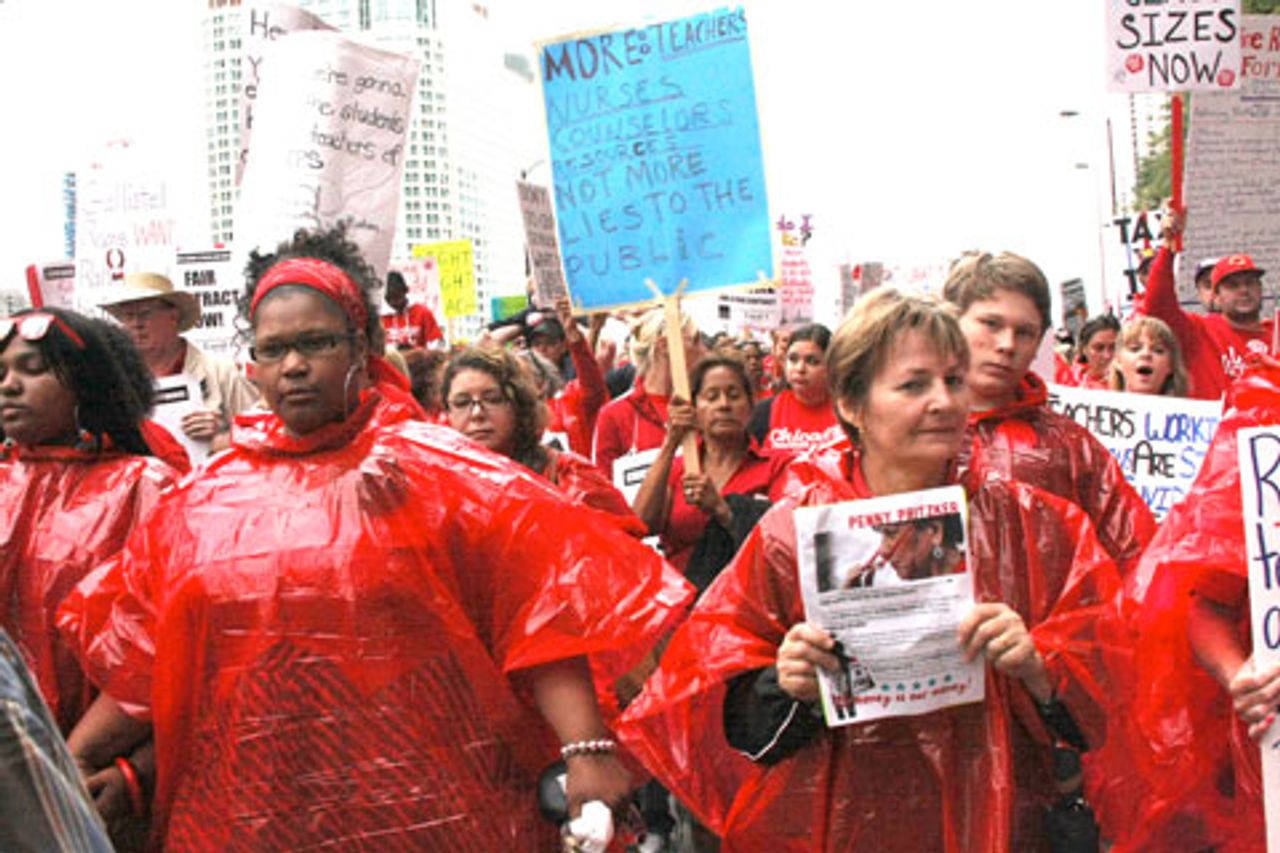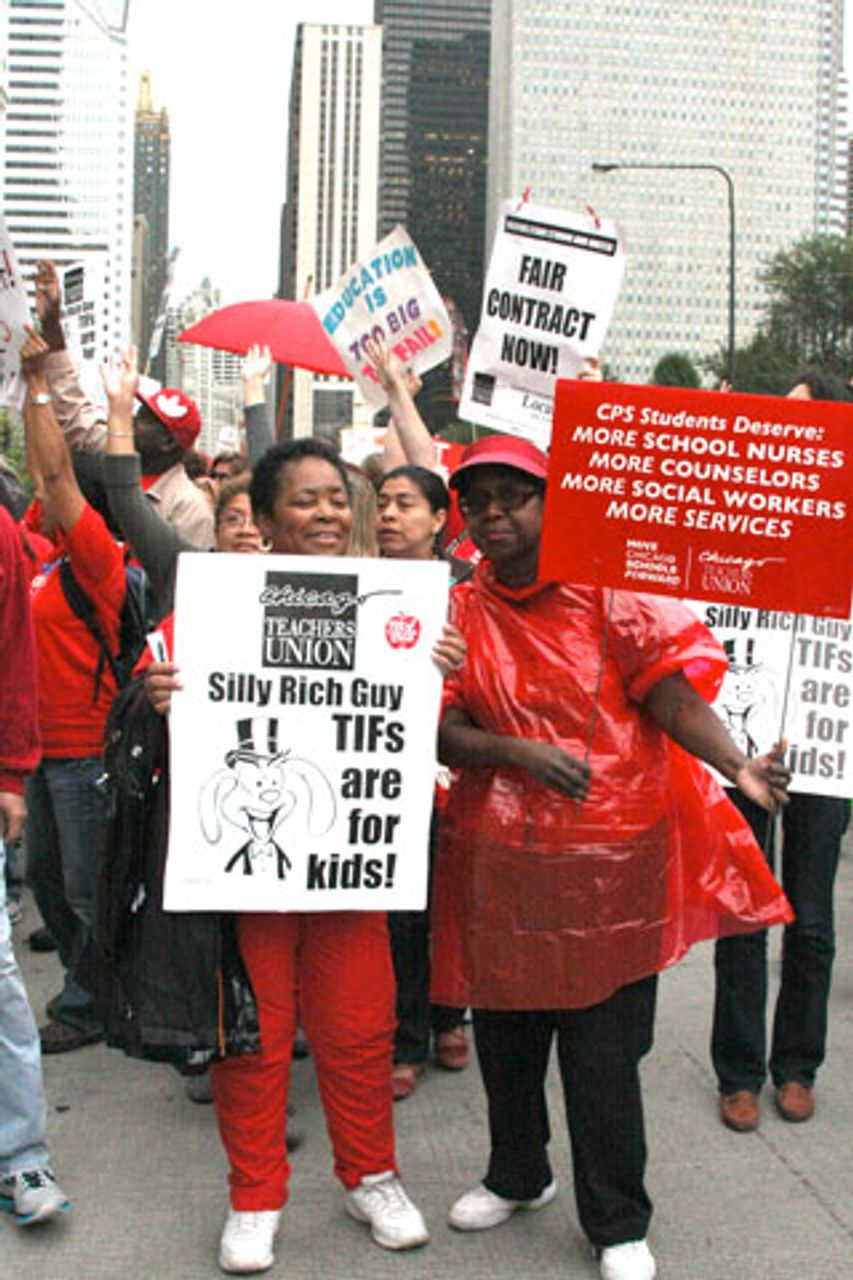“This has been a long time coming. I’m just glad I am here to be a part of it,” declared Dolores Jackson, a Chicago Public Schools (CPS) nurse demonstrating in support of the recent Chicago teachers strike.
 School nurses during the strike, Delores Jackson, left, and Linda Stewart
School nurses during the strike, Delores Jackson, left, and Linda StewartMany school nurses marched with the teachers, wholeheartedly supporting the overall defense of public education and opposing the cuts, which have affected the nurse-student ratios. Lack of in-school medical care for students has a direct impact on the educational environment, they told the WSWS.
“I cover five schools by myself,” Delores said. “That’s 3,500 students I have to care for. When students complain of being sick because it is too hot, what can you do? I rub some cold water on their foreheads, sit them in shade and fan them.
“It’s like picking up sticks and running all day. The best I can do is to try to educate the teachers in first aid because I can’t be there myself.”
 Striking teachers demonstrate at the Hyatt Regency Hotel
Striking teachers demonstrate at the Hyatt Regency HotelLinda Stewart, a nurse for 22 years, said that the nurses are also due for a contract with CPS, and while it is separate from that of the teachers it will be modeled on that agreement.
“We are protesting with the teachers because we want better conditions for the nurses too,” she said. “We are trying to get more nurses into the schools so that the conditions are better for the students and the teachers.”
Linda added, “According to the National Association of School Nurses [NASN] we are supposed to have one nurse to 750 students. Presently we have one nurse to 2,000-3,000 students. Twenty years ago I had two schools I covered with 1,000 students. Today, I also travel to five different schools.”
The NASN says there should be one nurse for 125-775 students, depending on the students’ health needs. Based on this figure, the Chicago Teachers Union (CTU) says CPS should have a minimum of 684 nurses—triple the nurses presently in the system.
Cameron Traut, former president of the Illinois Association of School Nurses, told Medill Reports of Northwestern University that the problem is not a lack of nurses in the state, but the lack of funding from the districts to hire.
Traut points out that schools are looking to cut costs wherever they can and the nurse per student ratio is getting worse. When a school nurse retires, schools are hiring nonregistered nurses, hourly workers, or no one.
“We are here to support the teachers with the other social workers,” continued Linda. “The conditions are extremely difficult. We can’t do the professional job we were hired to do. It is very frustrating. Our kids deserve better. A healthy child is a child that can learn.”
Linda said the nurses go out of their way to help the students as much as they can. “We call their houses and speak to their parents to let them know what is going on,” she said. “We are the eyes and ears in the schools. Often parents don’t know about the health services that are available and that they need.”
According to a recent report issued by the CTU, “The Schools Chicago Students Deserve,” CPS has 202 nurses for 350,000 students in 684 schools. The report says there are no nurses in the charter schools. A staff representative of the CPS disagreed with the CTU statistics, claiming there are 320 staff nurses, and that the district uses an additional 100 nurses who supplement the needs of the schools, while stating she did not know if the district provides nurses specifically to charter schools.
Nevertheless, it is undeniable that the number of students who have access to in-school nurses is declining dramatically. The tentative agreement, which is subject to teacher ratification, calls for hiring more nurses “if the school board gets new revenue.” Given the claim that there is no money, and that the board is looking for other ways to carry out cuts, this proposition does not seem likely.
Delores underscored the challenges the nurses face with the enormous growth of poverty in Chicago. “It is just very difficult,” she said, explaining that it is not unusual for students to come to her because they are hungry. Eighty-six percent of Chicago’s students are eligible for free or reduced lunch and 36 percent of the city’s children live below the poverty level.
“Some students we have to give a breakfast to,” she added. “In all of my schools I keep a supply of crackers, bars and energy snacks. You can’t expect a child to learn if they are hungry.”
The growth of poverty brings with it the prevalence of adverse health conditions. The National Association of School Nurses reported that 18 percent of students in public schools nationally have a chronic health condition, including attention deficit disorders, Type 1 diabetes, epilepsy, and asthma.
Bitterly attacking the role of both the city and federal government, Delores said, “They are taking the money and giving it to those who don’t need it. It is stealing from our future, or what is left of it.”
She added, “I always said health care and education don’t provide a money line. You can see that what they want is immediate gratification. That is what the big people want.“
Today 59 percent of its Chicago families are considered low income, defined as twice the poverty level, or $34,340 a year for a family of three in 2007; and 33 percent are living below the poverty line.
The shortage of nurses in the Chicago schools is only one expression of a national crisis. According to NASN only 45 percent of schools in the US have a full-time nurse, with the average nurse caring for 2.2 schools. Some 25 percent of schools do not have a nurse at all.
A recent feature by the Wall Street Journal headlined “School Nurses’ New Role in Children’s Health” pointed to the critical role school nurses play in saving lives, with tasks varying from monitoring intravenous medication to treating anaphylactic shock arising from the growth of food allergies.
The lack of adequate health care for students is another shameful expression of indifference of the two big-business parties to the conditions facing working class youth.
Receive news and information on the fight against layoffs and budget cuts, and for the right to free, high-quality public education for all.
